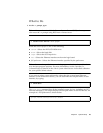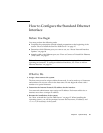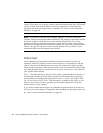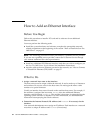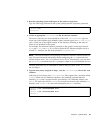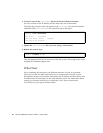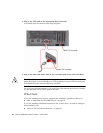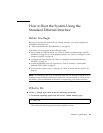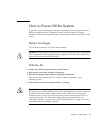
Chapter 2 System Setup 55
3. Boot the operating system and log on to the system as superuser.
Type the following command at the system prompt and the superuser password:
4. Create an appropriate /etc/hostname file for the new interface.
The name of the file you create should be of the form /etc/hostname.typenum,
where type is the Ethernet type identifier (some common types are eri, hme, le, nf,
and ie) and num is the logical number of the interface according to the order in
which it was installed in the system.
For example, the standard interface provided on the system’s main logic board is
eri0 (type = eri, num = 0). If you add a SunSwift PCI Ethernet adapter card as a
second eri interface, the file name should be hostname.eri1.
Note – The documentation accompanying the Ethernet interface should identify its
type. For more advanced information about configuring the eri software driver,
consult Platform Notes: The eri FastEthernet Device Driver. Alternatively, you can enter
the show-devs command from the ok prompt to obtain a list of all installed devices.
The host name also has an associated IP address that you enter in the /etc/hosts
file. See Step 6.
5. Type the host name, assigned in Step 1, into the /etc/hostname file for the new
interface.
Following is an example of the /etc/hostname files required for a machine called
zardoz, which has two Ethernet interfaces—the standard on-board Ethernet
interface (eri0) and a second interface provided by a PCI Ethernet adapter card
(eri1). The host name will be zardoz to a network connected to the standard eri0
interface, and zardoz-1 to a network connected to the eri1 interface.
zardoz # su
Password:
zardoz # cat /etc/hostname.eri0
zardoz
zardoz # cat /etc/hostname.eri1
zardoz-1





